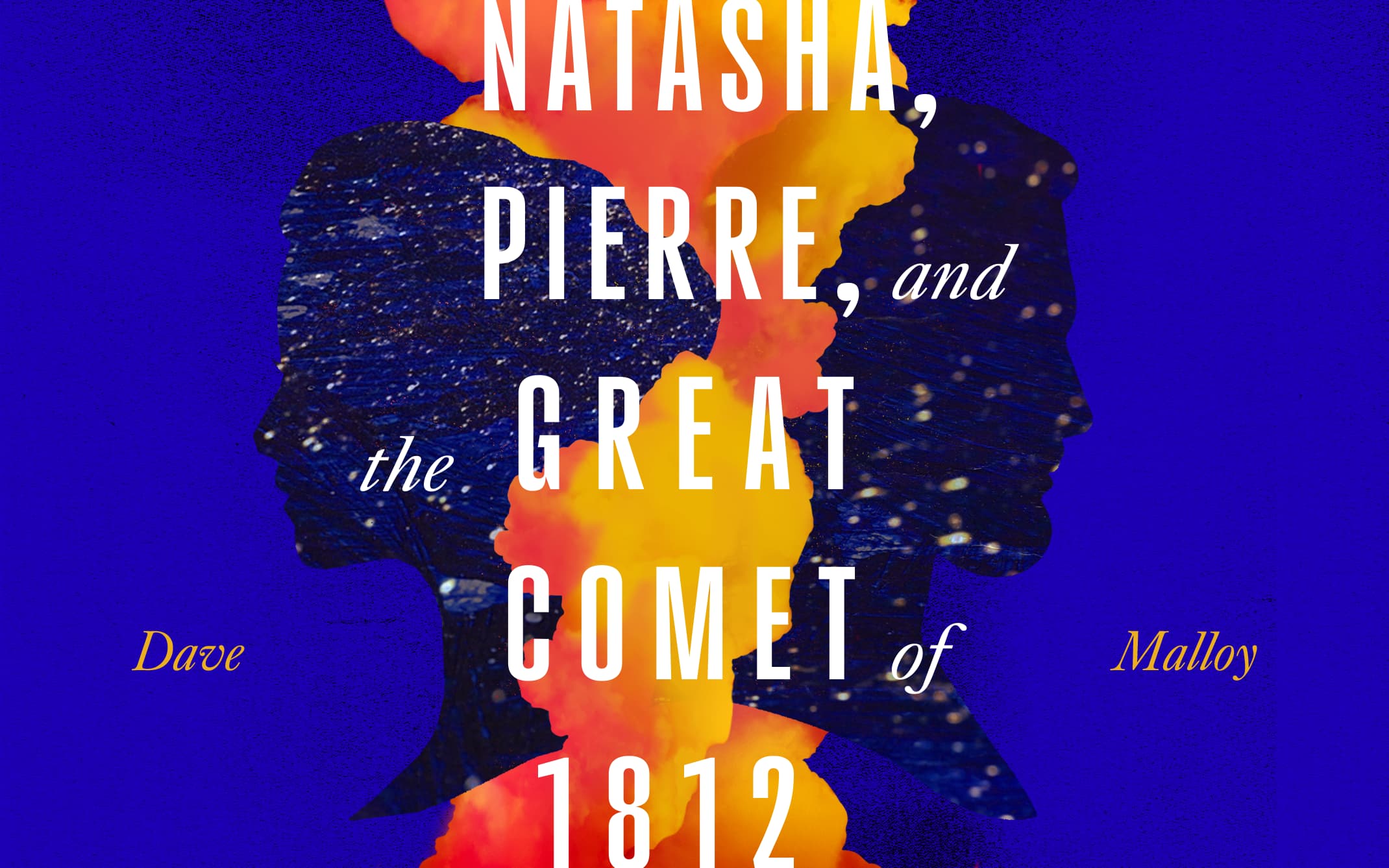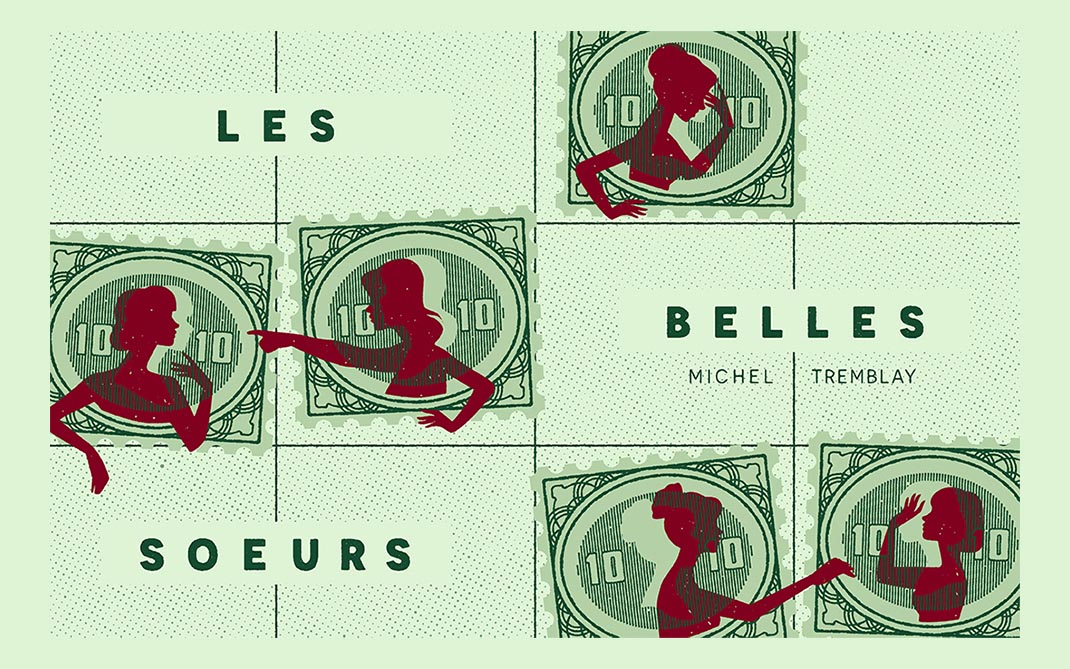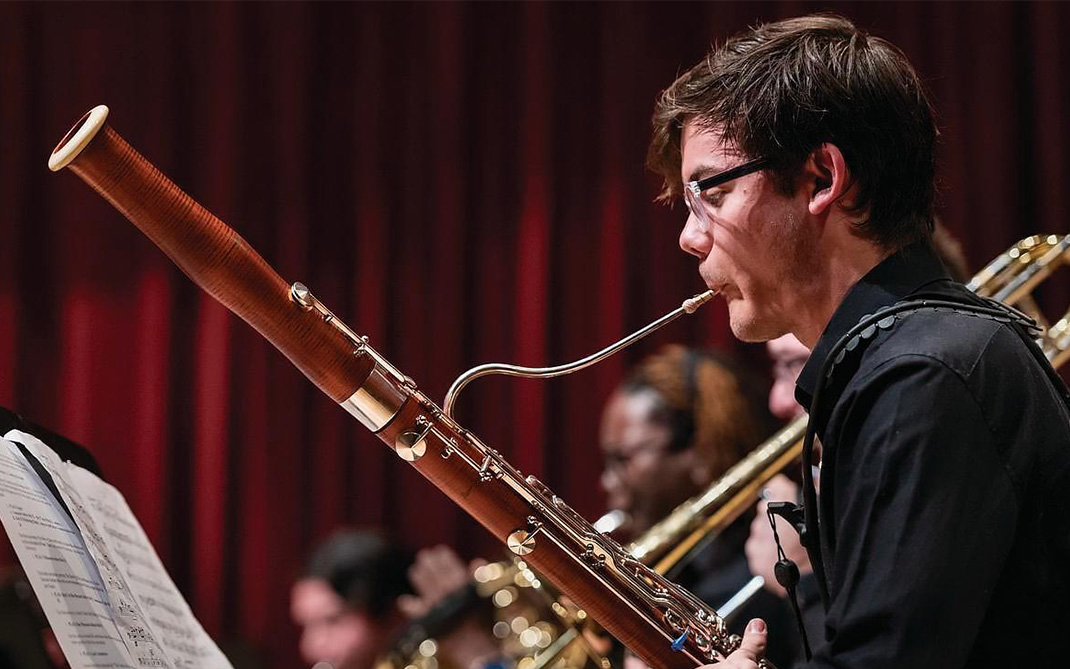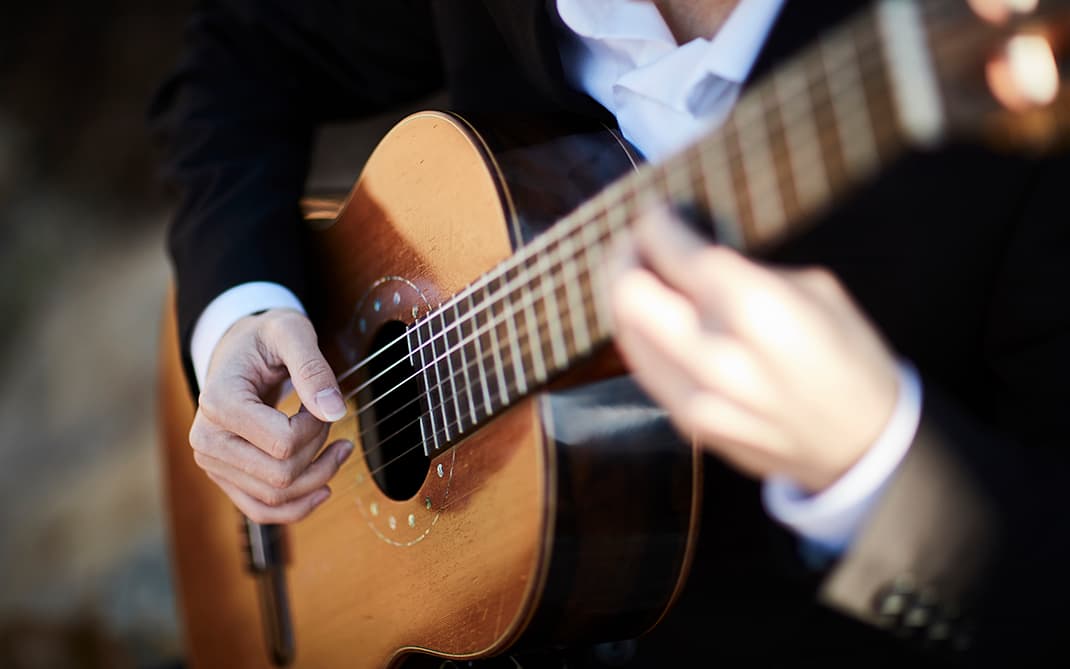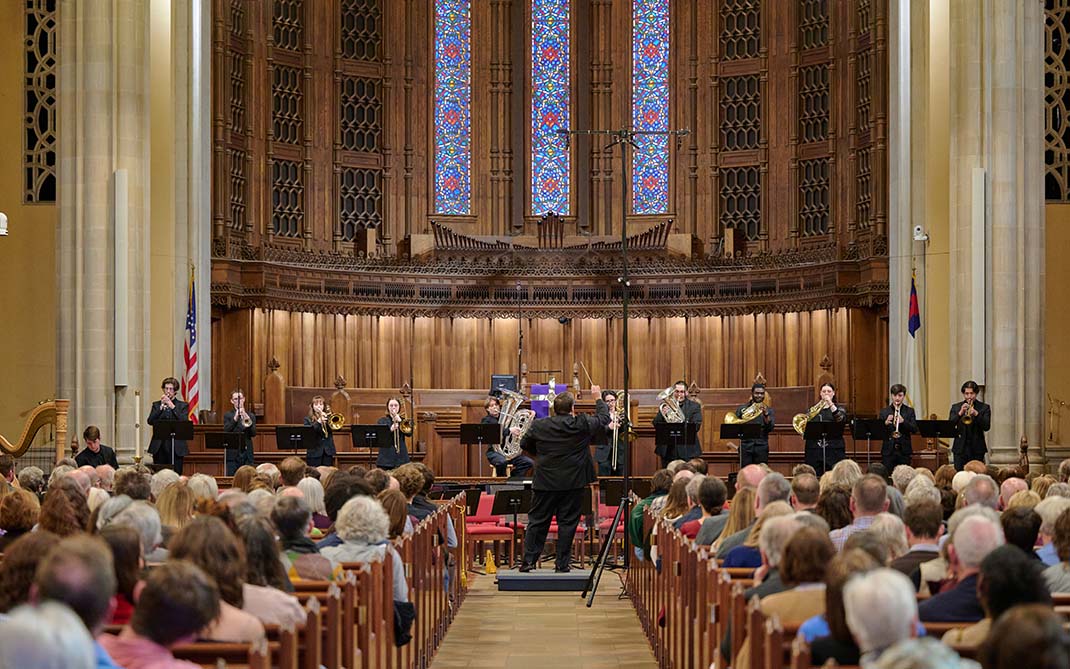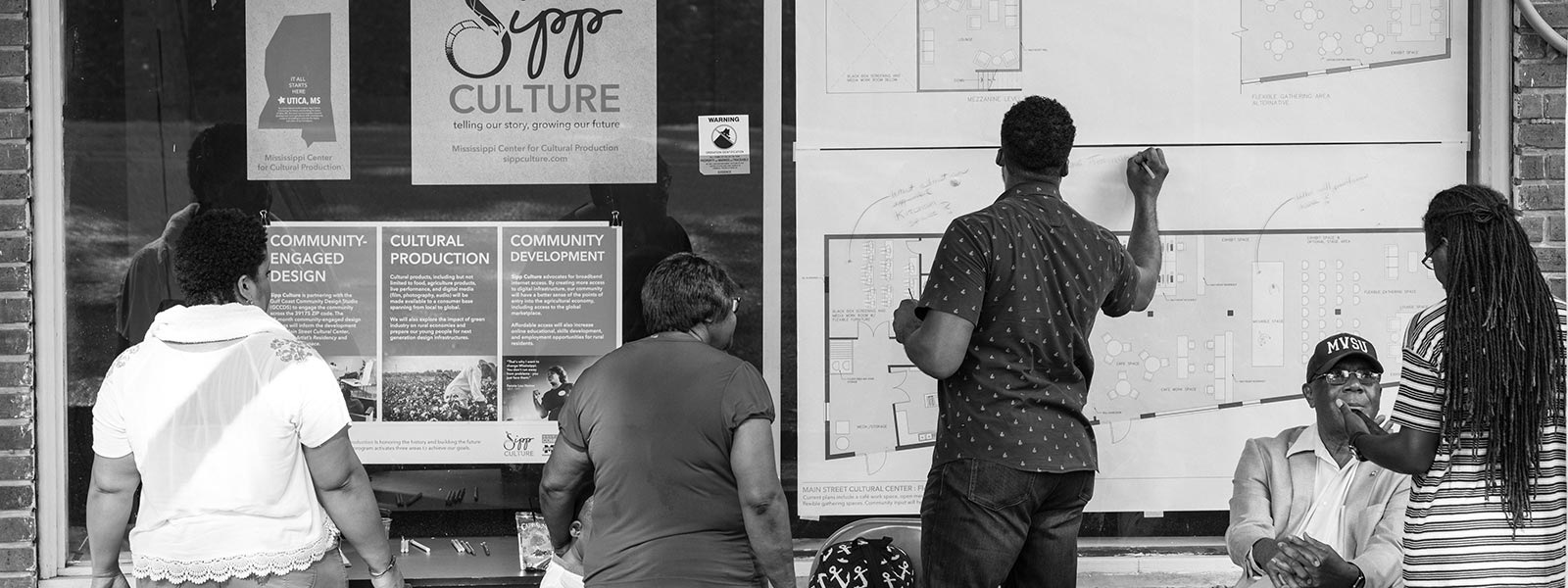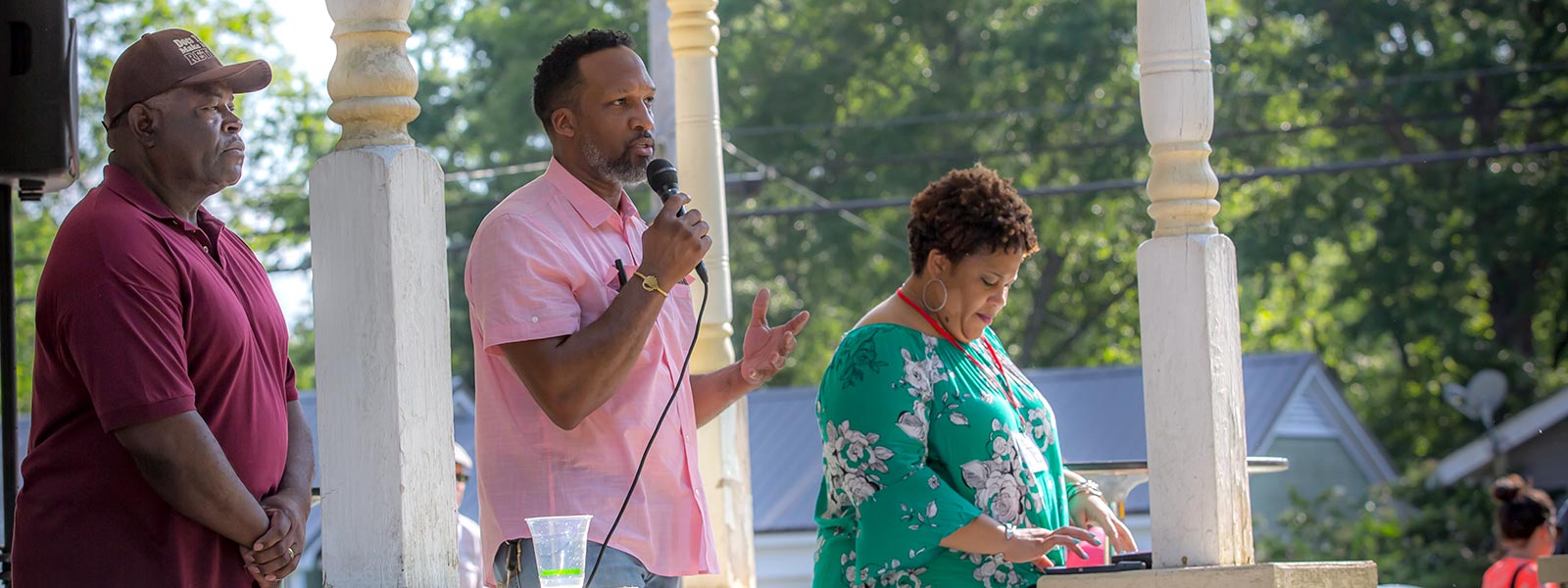Carlton Turner
The views and opinions expressed by speakers and presenters in connection with Art Restart are their own, and not an endorsement by the Thomas S. Kenan Institute for the Arts and the UNC School of the Arts. This interview has been edited for length and clarity.
Carlton Turner is an artist, agriculturalist, researcher and founder of the Mississippi Center for Cultural Production, also known as Sipp Culture. Sipp Culture uses food and story to support rural community, cultural, and economic development in his hometown of Utica, MS. Before founding Sipp Culture, Carlton was executive director of Alternate ROOTS, an arts-service organization based in the South promoting the creation of art rooted in community and advocating for social and economic justice for all.
A widely admired thought leader on the power and urgency of creative placemaking, Carlton speaks all over the country and is a current Interdisciplinary Research Fellow with the Robert Woods Johnson Foundation. He is also a former Ford Foundation Art of Change Fellow and a Cultural Policy Fellow at the Creative Placemaking Institute at Arizona State University’s Herberger Institute for Design in the Arts. He also currently serves on the board of First People’s Fund, Imagining America, and Project South.
As for his personal artistic projects, he is currently collaborating on a new performance piece titled “River Souls” with Meena Natarajan and Dipankar Mukherjee, the co-artistic directors of Pangea Theater Company in Minneapolis.
In this interview with Rob Kramer and Pier Carlo Talenti, Carlton describes how rooting his work and art firmly in his hometown has allowed him to investigate and question on a micro and macro level the many systems that determine a community’s overall well-being. He also celebrates how tapping into every community member’s innate creativity can be the first step toward civic transformation.
Choose a question below to begin exploring the interview:
- Can you talk about how the events of last year, from the pandemic to the murders in Minneapolis and Louisville and Atlanta, among so many others, have affected the way you view Sipp Culture’s mission? Have they changed any of your organization’s plans at all?
- I think a story that we often hear is of the artist growing up in a small rural community and then heading to the big city to do his or her art. What made you decide to stay and commit to making art in your community and your forebears’ community?
- For our listeners that might be interested in establishing a career in their hometowns or in a place besides some of the big cities that we typically think of as major art centers, can you talk nuts-and-bolts about what did you do to help transform Utica from a community that consumes art to a community that really produces its own art?
- Were you yourself particularly surprised by things you learned from your fellow community members about the way they view the community?
- What preconceptions do you think people have about the role that artists can play in rural communities, particularly rural communities in the deep South?
- Why do you think artists might be best positioned to be leaders in their communities in a way that they’re not doing currently?
Rob Kramer: Can you talk about how the events of last year, from the pandemic to the murders in Minneapolis and Louisville and Atlanta, among so many others, have affected the way you view Sipp Culture’s mission? Have they changed any of your organization’s plans at all?
Carlton Turner: I would say no. I think the work of Sipp Culture first and foremost is about cultural transformation, community development, looking at the work that we do in our small rural community and how it relates to the larger world around us in society. We use food and storytelling as our primary methods of connecting to community and of enacting our mission in the world. I think what we saw during the pandemic was this kind of freeze moment in which people were asked to pause, to kind of stop the world in a way, to stop doing what we had been accustomed to doing every day: getting up, going to work, going to the grocery store, going to the movies, going to a ballgame, going to the concert, going to church, going to whatever thing, schools, back and forth. This totally integrated society was then asked to segregate out into their own individual spaces.
However, for a lot of people in my community, they were considered frontline workers. They were people who were working in warehouses and in healthcare institutions and in maintenance spaces and truck drivers and people who had to continue moving as life dictated before the pandemic. They had to take the risks that the rest of the country was being asked to not take and not being either acknowledged for their sacrifices and their vulnerability or compensated. In that respect it was very much like the America that Black folks know. So it stopped in that respect.
The other part about it that I think has been really important to Sipp Culture’s work is how the pandemic impacted the food infrastructure. What we saw was this kind of throwback in our community, a community that historically and traditionally has provided a huge amount of its own food, from small farms to just being based around the entire agricultural industry, that community reverting back to a space in which we’re lining up at the community center to get these USDA boxes of commodities. That reminded me of my early days as a youth and remembering people in my community that produced food, going and standing in line to get government cheese and powdered eggs and powdered milk and these things.
I think in many ways we realized that the work that we’re doing around food and story is more integral now than it was before. And I think if nothing else people were more awakened to the work that we’re doing ... Now they’re like, 'Oh, we see exactly why you mix arts and agriculture.'
I think in many ways we realized that the work that we’re doing around food and story is more integral now than it was before. And I think if nothing else people were more awakened to the work that we’re doing and seeing it as relevant, to where before they were like, “How are you actually mixing the arts and agriculture?” Now they’re like, “Oh, we see exactly why you mix arts and agriculture.” I think those were some of the pieces that hit us the hardest and made our work really more relevant and more compounded.
I think the issues around police brutality, they’ve always been there. I live in Mississippi. The history of Mississippi is that all of our governmental and law enforcement systems were all integrated with white supremacists and Ku Klux Klan members. They killed the three civil rights workers in Philadelphia, MS in the ’60s. They were responsible for beating Fannie Lou Hamer nearly to death in prisons in Mississippi. They were responsible for attacking people trying to go and get the right to vote. And here we are today. We’re in a similar moment in which our right to vote is being challenged and we are oppressed around the country but mostly in Southern states. That’s not a coincidence. We’re seeing these same issues grow and develop.
I think for the rest of the world, it was a wakeup. For Black America, it seemed like OK, finally people are seeing what we’ve been going through for a long time.
Pier Carlo Talenti: I think a story that we often hear is of the artist growing up in a small rural community and then heading to the big city to do his or her art. What made you decide that your art was going to be inextricably tied to your community? What made you decide to stay and commit to making art in your community and your forebears’ community?
Carlton: Maturity. [He laughs.] Realizing that, one, they don’t need another Carlton Turner in New York City or Chicago or Los Angeles or San Francisco. In those spaces my contributions are to New York City; they’re not to the development of something that belongs to me. And it’s itinerant; I can come and go. And New York isn’t going to change. They won’t change because of my presence; they won’t change because of my absence.
But my home community, every time someone chooses to leave here, whether it be for lack of opportunity or for any reasons, it impacts the community in profound ways. It impacts the quality of services that our community has, whether that be doctors that are leaving or lawyers that are leaving or professionals like grocers or engineers. It’s not that our community doesn’t produce these things; it’s that they don’t have connectivity to say, “I want to stay here, and I will sacrifice the interim for the long term.” I think that’s a sacrifice that a lot of people feel uncomfortable making.
I didn’t feel it was a sacrifice myself because my role and position, both as an artist but also as a leader in the arts through the work of Alternate ROOTS, allowed me access into a lot of different communities. I got a chance to travel and see what was happening in San Francisco and in Minneapolis and in New York City and in Atlanta and in San Antonio and in South Dakota and all of these places where I have relationships, I have people that are working on the ground there. I was able to engage in ways that both endowed me with a sense of purpose, like what it means to do work in those communities? What does it mean for the people who live here that have never left? What does it mean for me as a person who’s entering this community? How do I enter and exit in a way that is consistent with my values and principles and practices, as taught by the great Jawole Jo Zollar from the Urban Bush Women? But also how do I make an investment of the resources, the networks, the information skills back into the community that I come from that actually made me who I am, that invested in me values and integrity and foundational principles that show up in the way that I’ve shown up in every other community?
For me it wasn’t a sacrifice as much as it was wanting something different because my family is here. The children, the offspring of my cousins and my uncles and my aunts, all live in this community, and if we’re not making an investment here, then eventually they all leave and the place that we call home is no longer home.
For me it wasn’t a sacrifice as much as it was wanting something different because my family is here. The children, the offspring of my cousins and my uncles and my aunts, all live in this community, and if we’re not making an investment here, then eventually they all leave and the place that we call home is no longer home.
Rob: For our listeners that might be interested in establishing a career in their hometowns or in a place besides some of the big cities that we typically think of as major art centers, can you talk nuts-and-bolts about what did you do to help transform Utica from a community that consumes art to a community that really produces its own art? Specifically, what was the process you did to engage the community, the people, and then ultimately impact and change the culture?
Carlton: Well, I would say first and foremost that the work is ongoing and it’s really at its beginning stages. We, my wife and I, founded the Mississippi Center for Cultural Production in Utica, which is unceded Choctaw and Natchez land, in 2017. We began that work working with a team of architects and designers, and we started a community-center design process. We started with just 18 months of conversation, asking the community to take a complete look at itself, to do some critical analysis around what they found.
We put these big maps up on the wall of the tri-county area with a lot of detail. We asked the community to plot four places. We wanted to know where do you live, where do you work, where do you shop, and where do you worship? What we saw is that people drew these lines out of the community, and what we realized is that everything happens outside of Utica except sleeping. People sleep here, so we’re now a bedroom community, where if we go back 50 years, the community was actually a center of commerce, it was a center of activity because it had a railroad, it had three cotton gins, it had a radio station, it had an opera house, a small community college, HBCU. It had all of these things, and so many of those things have perished and gone away. What’s left is houses. There’s not a lot of new houses being built. The community had to come to grips that it’s now a bedroom community.
Then we asked the question, “Now that you’ve accepted that this is the reality, are you content with that being the identity of the community? If not, then what is the identity that you’re interested in assuming?” Then we can begin to design and plot our way back from that desire to where we are today so that we can have a pathway to get there. This is foundational work.
We’re not even five years into the work, so we haven’t transformed the community. What we’ve done is we’ve provided an outlet for the community to input their ideas and their dreams.
We’re not even five years into the work, so we haven’t transformed the community. What we’ve done is we’ve provided an outlet for the community to input their ideas and their dreams. Even that process is one that is iterative and growing and developing. I would say that we haven’t accomplished any of what we set out to accomplish but we’re on track for that work to happen and for us to see results over a 20-year span. Because this is generational work.
Pier Carlo: Were you yourself particularly surprised by things you learned from your fellow community members about the way they view the community?
Carlton: Not surprised. I’m a very difficult person to surprise. I think in many ways it affirmed things that I thought. In that affirmation, I probably suffered a little excitement and a lot of disappointment. I think what I imagined was a chief concern of the community, from my vantage point, was the impact of both, I think, the larger impact of capitalism, which impacts our community in so many different ways but is responsible for the demise of Main Street, the emergence of Walmarts and the North Atlantic Free Trade Agreement, which took manufacturing to various countries, especially textiles and things that impacted our community. We used to have a shirt factory, a sewing factory. Those things are really huge.
Then the impact of education and what Bob Moses, who is one of my early mentors, says is a sharecropper education, which is enough education just to keep you owing somebody else for the rest of your life. The impact of those things has changed the quality of imagination and the ability to innovate into new ideas or even to latch onto old ideas that are still useful.
One of the things that we talk about in our community is about food and what role food plays and how important food is. We are a community that used to have several grocery stores. We used to have a lot of people producing fresh produce and producing poultry and pork and beef. All of those things have gone away, including the grocery store. Now the place where people shop locally in Utica is the Dollar General store, which has a small produce section and mostly frozen and canned foods. That’s a huge turnaround from what the community was 30 years ago.
But when we posed a question to the community, “What can we do about this?” almost across the board what people say is we need another grocery store. That defies the logics of economics, because if we’re only a bedroom community, it means that there’s no industry here, there’s no jobs here, which means that grocery stores are going to opt to go to places where there’s actually jobs because that’s where people are going to spend money. People shop where they work. When there were businesses in town, people shopped in town, but now people are working in Jackson or working in Crystal Springs or working in Vicksburg. They shop in Jackson, they shop in Crystal Springs, they shop in Vicksburg.
When we think about the economics of a grocery store, the community sees the lack of a grocery store as a result of failed leadership. But they’re looking at the local level, so they’re blaming it on the mayor, they’re blaming it on the city councilmen or the aldermen. They’re not looking at the larger federal policies that have changed the way that factories work or the places where industry is being invested in. Those are the places where I feel like as a community we could learn from some unpacking of our community’s history, some unpacking of political education that helps us to understand the larger impacts of the global economics and how those things show up in Utica, and not think that the mayor actually has any power to bring back a grocery store. Because he doesn’t.
Rob: What preconceptions do you think people have about the role that artists can play in rural communities, particularly rural communities in the deep South?
Carlton: I think that art is still such a misunderstood word and such a narrowly defined concept for people who don’t consider themselves artists or creators, and I think that that impacts the way that people see art playing a role in community development and in community transformation. Art is seen as either very specific to visual art — something that you paint or hang on the wall or something that you gaze at in a museum or an art exhibit — or it’s looked at as performance, theater or music. Even the music is difficult for, I think, our rural communities to think about because music is such an ingrained part of their life. It’s such a part of the culture that they don’t necessarily even think of that as art. They just think of that as what it is, which is just this human expression that is just a part of who I am. Everybody’s into music.
I think that this idea that art is something that is done to you hinders the ability for art to be seen as a more comprehensive tool for community development or even for community communication. We use a lot of story as the basis for all of our gatherings. We use story and memory as a place where we start our conversations. So if we’re having a community event like the one we did a couple of weeks ago in which we were talking about the development of a community cultural space on Main Street, we started with the question, “Can you share with us a memory that you have of Main Street? What is your favorite memory of that space up there?”
People began to just talk about as a child coming to Main Street with their parents or their aunties or their grandmama or going into one of the stores on Main Street and what they would purchase there, what the atmosphere was there, what it smelled like, what it looked like, what it felt like. They would begin talking about the railroad and how they remember seeing the train go through town. All of these memories start to flood back. It gets people not to just look at those as moments of nostalgia but look at those as information technology.
What we’re doing is we’re mining the memory to understand what has already been capable on Main Street, so you can’t tell us what we can’t do because we already know that this has happened before in this space. I think those are the methodologies that have been really useful for us. I don’t think anybody thought about that as an artistic exercise. They thought of it as a question, that moment that you were transported through this question from your seat to Main Street in a time warp in which you moved, let’s say, 20, 30, 40 years into the past to access a memory and bring that memory forward as an opportunity to think about the future.
What we’re trying to do is demystify the role of the artist and the role of the arts and to reintegrate arts back into culture and take it out of performance and into the idea of embodiment.
What we’re trying to do is demystify the role of the artist and the role of the arts and to reintegrate arts back into culture and take it out of performance and into the idea of embodiment. To me, those are the things that are very different from the way that the world treats art as a commodity, as something to be mined for the value that it possesses, not the intrinsic value but the profit that can be extracted from the product. Our framework is about, one, that we have our own uses for that art and culture: for us to build value that is important for us locally and realize that if we think about the production of culture as a comprehensive framework for how our community works, then we can begin to change our perception of what it means to be cultured, what it means to participate in the arts, what it means to consume culture.
Those are the things that I think we’re working with and trying to figure out in our local community.
Pier Carlo: Why do you think artists might be best positioned to be leaders in their communities in a way that they’re not doing currently?
Carlton: This is the easiest question in the world! I think, one, no matter what we’ve been told, all of us are creative. Every human born has the ability to create. It’s such a wonderful gift, right? Artists are the ones who made it to adulthood — and not all artists are adult, but I’m just using this as a ... just hang with the picture for a sec — artists are the ones who made it to adulthood refusing to believe everyone that told them that they were not creative, and they continue to hold on to whatever that is inside of us that helps us to create, that helps us to build and imagine. They never lost it, and they’ve honed the ability to tap into that source any time they need to manifest something that doesn’t already exist.
That’s why artists are essential to building a new world, because everybody else, most of the other people are fixed in doing it the way that it’s been done. It’s like, “We only know how to do it like this because that’s the only way we’ve ever been shown.” Artists are like, “Well, you can do it like this, but you can also do it like this. You can do it like that too. Maybe over here you can do it like this.” People are uncomfortable with change — that’s just first and foremost — but I think people are also uncomfortable with having a lot of options and a lot of ideas. And so we have to make idea generation and the refining of ideas through collective community critique part of our collective critical analysis.
That’s what’s going to build the cities of tomorrow and the cities that we need today. That’s different from the way that I think most leaders approach community development and city management, which is from operating those spaces as businesses or corporations. Artists tend to look at these as landscapes and built environments that are still in need of refinement and design and input from a collective. Creativity is essential to the development of the 21st century society, and artists are most prone to do that because of the way that we can access creativity.
July 12, 2021
